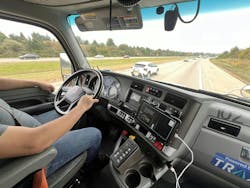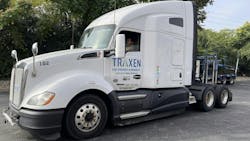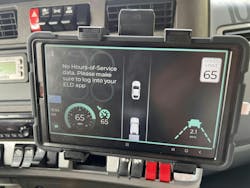PLYMOUTH, Michigan—Analysts and industry experts can disagree over when the trucking recession will end, but it's the fleets, managers, and owner-operators who have to make ends meet. One way carriers have sought operational savings is through efficiency.
This might look different for every fleet. Fleet Maintenance affiliate FleetOwner detailed some of the ways real fleets are increasing efficiency this year: Strategies included increasing aerodynamics, using electric power equipment, using a fleet management system, using wheel components that generate less friction, and using Traxen’s advanced cruise control system, iQ Cruise.
I recently had the opportunity to experience Traxen’s iQ Cruise through a ride-along in a tractor equipped with the system. This opportunity included a look at the system’s real-world performance as well as a more detailed look into the system itself—which has proven to increase fuel efficiency by up to 7%.
What is iQ Cruise?
IQ Cruise, developed by Traxen and distributed by Eaton, is an advanced cruise control system that can be retrofitted onto any truck with an automatic transmission. While the system has multiple benefits, fleets will most likely be interested in it because of its potential to improve fuel efficiency.
Using radars, 3D mapping, and data from multiple sources—such as weather services, the weight of the load, and any grades that are in the truck’s path—iQ Cruise controls the truck’s engine output to maintain speed and distance from the vehicle ahead, in a way that’s most efficient according to the condition of the road and the weight of the truck’s load.
Enabling iQ Cruise removes “variations” of driver behaviors—such as aggressive acceleration and harsh barking—and provides consistency and efficiency, Tim Bauer, VP of aftermarket, Eaton Vehicle Group, said.
“There is a wide variation of fuel economy across a fleet’s driver pool,” Bauer told me. “Our system is trying to ensure that variation becomes more narrow, and the efficiency emulates closer to the best driver behavior.”
See also: Put me in, coach: How driver coaching decreases maintenance
Results from fleet pilots have proved that removing this behavioral variation can provide a 7% increase in fuel efficiency, even when used only 45% of the eligible time. “Eligible time” consists of traveling on highways and interstates at high speeds.
The system could be described as “set it and forget it.” During the ride-along, I watched as the driver never touched the brake or the accelerator pedals after we turned to merge onto Interstate 275. The driver didn’t even have to accelerate on the ramp to enter I-275, as the system was already aware of the truck's location and the speed limit of the highway and adjusted the throttle accordingly.
What’s more, the driver never had to increase or decrease the set speed to travel. The system has speed limit information data and automatically sets the cruise control speed within a range of a few miles per hour based on GPS data or a governed speed. This allowed the driver to focus on the road—and answer my questions.
Many trucks today are equipped with adaptive cruise control systems and even some predictive cruise control systems. But the iQ Cruise is even more advanced than that, Ali Maleki, Traxen founder and CEO, said.
“The existing systems are adaptive cruise control and predictive cruise control,” he said. “We do both at once.”
Unlike a typical cruise control system with a focus of maintaining one speed, the iQ Cruise system stays within a range of a set speed. This is ideal for trucks hauling heavy loads that have a hard time maintaining 65 mph going up a steep grade. It’s also ideal for those same trucks that can benefit from coasting at 67 to 68 mph down that steep grade, where a typical cruise control system—or even a predictive cruise control system—would implement braking to maintain that 65 mph speed.
I experienced this in the cab. The system, which was aware of an upcoming grade via 3D road mapping data, began accelerating for a more efficient climb while the grade was still a significant distance from us. This prevented more strain on the engine when ascending the grade.
If weather data indicates rain, for example, the system will automatically adjust the truck’s speed to accommodate a safer traveling distance when traversing wet pavement.
The system also uses a truck’s existing radar system that many are equipped with from the factory today. However, if no radar system exists, Traxen provides the radar and can install a complete system within 2.5 hours.
Efficiency for the long haul
Because the iQ Cruise system removes those driver behavioral variations as well as predicts road conditions, iQ Cruise enables drivers to better manage their fuel economy, resulting in increased fuel efficiency.
Increasing fuel efficiency can lead to multiple benefits for fleets. One of which is obvious—monetary savings.
FleetOwner recently reported that the typical long-haul tractor-trailer's mileage is about 1,000 miles per tank. If a fleet employing iQ Cruise saw a 7% increase in fuel economy, that fleet would benefit from an additional 70 miles of travel on one tank. That’s a savings of 12 gallons of fuel for the average tractor-trailer (5.75 mpg), which equates to $42.48 with diesel's current average price at $3.54 per gallon. Multiply that by the number of fill-ups in a fleet per day, week, month, or year, and that’s a hefty savings.
Another benefit of increasing fuel efficiency is the sustainability aspect.
Sustainability solutions for fleets today largely center around purchasing new trucks with new propulsion systems that aren’t quite ready for long-haul operations. But iQ Cruise can help fleets meet sustainability targets using the existing trucks in fleets today, Chris Slesak, Traxen chief product officer, said.
Fleets that must adhere to specific sustainability targets, those that have strict ESG goals, or those with customers who prioritize sustainability will greatly benefit from the efficiency impact of iQ Cruise because of their trucks’ decreased emissions.
When accounting for a 7% increase in fuel efficiency by enabling iQ Cruise, a fleet could potentially decrease its CO2 emissions output by 1,571.5 pounds per tank, assuming one gallon of diesel emits 22.45 lb. of CO2 and the truck travels 1,000 miles on a tank of diesel. That’s the equivalent of emitting more than one and a half pounds less CO2 per gallon at 20.89 lb.
Additionally, equipping 500 trucks with iQ Cruise would reduce CO2 emissions by 14,000 tons if the drivers of those trucks used the system 40 to 60% of the eligible time, Maleki said.
See also: ‘Destined to fail’: Trucking leaders, Congress question GHG3 final rule
Fleets suited for iQ Cruise
Not every fleet will benefit from employing iQ Cruise, and the Traxen and Eaton teams have been transparent about that fact.
Part of Eaton’s role in the partnership is to use its existing relationship with fleets to decide where to place real-world iQ Cruise pilots. Eaton uses a small checklist to decide whether a fleet would benefit.
Bauer said fleets that don’t typically use cruise control, such as urban and rural operators, would not benefit from the iQ Cruise system. “That’s not necessarily a focus area of the technology,” he said.
“We’re looking at fleets that are running 80,000 miles [a year], or maybe they've got tandem drivers, and they do quite a bit of freeway usage,” Bauer continued. “Those are the candidates for us.”
iQ Cruise also works well for long-haul trucking in any region, but Maleki told me, “The more variations in speed, the better we do ... If you add traffic to [the route], if you add weather to it, then [iQ Cruise] will do better—always,” he said.
This article was originally published on FleetOwner.com.







